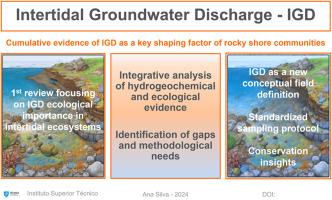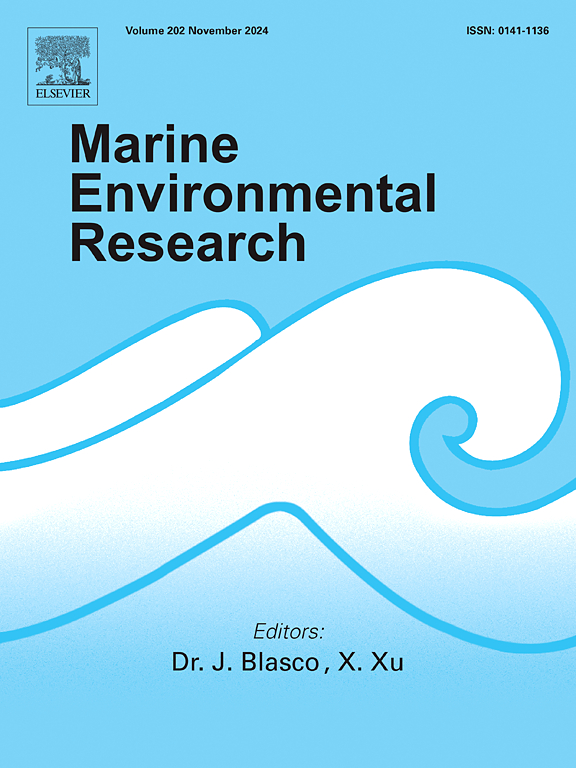Standing at water edges: Ecohydrological interactions between coastal groundwater discharge and intertidal community dynamics
IF 3.2
3区 环境科学与生态学
Q2 ENVIRONMENTAL SCIENCES
引用次数: 0
Abstract
The intertidal zone on rocky shores is of key ecological importance because it supports high biodiversity, provides critical ecosystem services such as nurseries and refuges, and facilitates complex species interactions in the transition to offshore areas. Important local shaping factors such as groundwater discharge complexify the ecological dynamics of rocky shore communities. The role of submarine groundwater discharge (SGD) in coastal ecosystems is well established. Here, I introduce the Intertidal Groundwater Discharge (IGD) concept to provide a standardised format for distinguishing it from other discharge types. Despite receiving recent increased attention, the importance of direct inland groundwater discharge into intertidal rocky habitats is still scattered. Rocky shores are hallmark habitats long hailed as biodiversity hotspots and key ecological players in adjacent environments; however, consolidated scientific assessments of GW-ecology linkage features and vulnerabilities are lacking. This review is the first to merge fragmented research and identify gaps in knowledge and methodological needs in assessing groundwater-mediated ecological intertidal processes. By filling these gaps, we can gain insights into the vulnerabilities of coastal ecosystems to climate-driven changes related to groundwater availability and design strategies that promote ecological resilience. Rising sea levels, altered precipitation and temperature patterns, and resource exploitation and pollution are increasing threats to the sustainability of rocky shore communities. Here, I integrate hydrogeochemical insights into the broader ecological context of these biodiversity hotspots to develop informed conservation strategies that safeguard the stability and functionality of dynamic and vulnerable habitats.

站在水边:沿海地下水排放与潮间带群落动态之间的生态水文相互作用
岩石海岸的潮间带具有重要的生态意义,因为它支持高度的生物多样性,提供关键的生态系统服务(如育苗场和庇护所),并在向近海区域过渡的过程中促进复杂的物种相互作用。当地的重要影响因素(如地下水排放)使岩岸群落的生态动态变得更加复杂。海底地下水排放(SGD)在沿岸生态系统中的作用已得到公认。在这里,我提出了潮间带地下水排泄(IGD)的概念,为区分潮间带地下水排泄与其它排泄类型提供了标准格式。尽管内陆地下水直接排入潮间带岩石栖息地的重要性近来受到越来越多的关注,但这一问题仍很分散。岩石海岸是标志性的栖息地,长期以来一直被誉为生物多样性热点和邻近环境中的关键生态角色;然而,目前还缺乏对全球降水-生态联系特征和脆弱性的综合科学评估。本综述首次合并了零散的研究,并确定了在评估地下水介导的潮间带生态过程方面的知识差距和方法需求。通过填补这些空白,我们可以深入了解沿海生态系统在与地下水可用性相关的气候驱动变化面前的脆弱性,并设计出促进生态恢复能力的策略。海平面上升、降水和温度模式改变、资源开发和污染对岩岸群落的可持续性构成了越来越大的威胁。在此,我将水文地质化学的见解与这些生物多样性热点地区更广泛的生态环境相结合,以制定明智的保护战略,保障充满活力的脆弱栖息地的稳定性和功能性。
本文章由计算机程序翻译,如有差异,请以英文原文为准。
求助全文
约1分钟内获得全文
求助全文
来源期刊

Marine environmental research
环境科学-毒理学
CiteScore
5.90
自引率
3.00%
发文量
217
审稿时长
46 days
期刊介绍:
Marine Environmental Research publishes original research papers on chemical, physical, and biological interactions in the oceans and coastal waters. The journal serves as a forum for new information on biology, chemistry, and toxicology and syntheses that advance understanding of marine environmental processes.
Submission of multidisciplinary studies is encouraged. Studies that utilize experimental approaches to clarify the roles of anthropogenic and natural causes of changes in marine ecosystems are especially welcome, as are those studies that represent new developments of a theoretical or conceptual aspect of marine science. All papers published in this journal are reviewed by qualified peers prior to acceptance and publication. Examples of topics considered to be appropriate for the journal include, but are not limited to, the following:
– The extent, persistence, and consequences of change and the recovery from such change in natural marine systems
– The biochemical, physiological, and ecological consequences of contaminants to marine organisms and ecosystems
– The biogeochemistry of naturally occurring and anthropogenic substances
– Models that describe and predict the above processes
– Monitoring studies, to the extent that their results provide new information on functional processes
– Methodological papers describing improved quantitative techniques for the marine sciences.
 求助内容:
求助内容: 应助结果提醒方式:
应助结果提醒方式:


